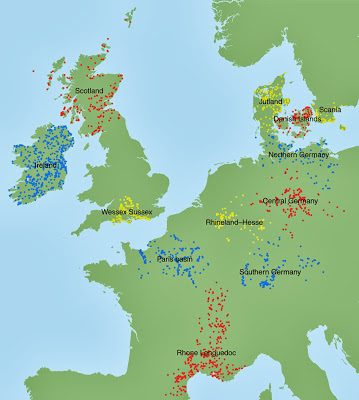Early agriculture had dramatic effects on
humans
The introduction of agriculture in Europe was followed by regional population crashes despite trends of demographical growth, reports research published in Nature Communications this week. Sean Downey, assistant professor in the University of Maryland's Department of Anthropology, was co-author of the paper. The work suggests that these sharp population decreases weren't due to changing climatic conditions, and therefore the authors propose internal causes. The research represents a major revision to our understanding of how the introduction of agricultural technology impacted humans.
Stephen Shennan, professor of theoretical archaeology at the Institute of Archaeology, University College London, received grant funding from the European Research Council to study early agriculture and its impact on populations across Europe. His multidisciplinary team of researchers includes co-author Downey, and Mark Thomas, Research Department of Genetics, Evolution and Environment, University College London, who designed the statistical analysis necessary to produce the findings.
Agriculture was introduced in the Aegean (modern day Turkey) around 8,500 years ago and steadily spread across Europe, reaching France around 7,800 years ago, and Britain, Ireland and northern Europe approximately 6,000 years ago. In all instances, the introduction of agriculture meant a drastic change in food production and consumption patterns, which led to a population boom. Utilizing radiocarbon dating, and an innovative new method for improving the accuracy of this data, the study's authors examined how population levels changed over time across Europe during the late Mesolithic, ("Middle Stone age") and Early Neolithic ("New Stone age").
The research team discovered that, in all of the 12 different European regions studied, from the South of France to Scotland and Denmark, drastic population fluctuations can be observed. In fact, they note that in some cases population declines were as significant as 30-60 percent from the highest levels achieved after the introduction of agriculture. These dramatic changes in population are of similar scale to the decrease estimated for the much later "Black Death".
The authors found that those fluctuations cannot be associated with climatic factors; however, the exact reasons for this population decline remains unknown.
"It's striking that the development of agriculture – one of humanity's major evolutionary steps – failed to buffer against widespread social collapse during this early period of rapid population growth in Europe," explains Downey. "At this point in the research we can only speculate at the direct causes, but the study demonstrates that agriculture-based societies in the past were vulnerable to population collapse on a broad scale." Downey continues by explaining the study's finding: "There were no correlations between the collapse of regional populations and known climate shifts. It wasn't the climate, so we think it must have been the long-term impact new agricultural technologies had on local environments in reducing resources. The stress this caused among farmers was likely exacerbated by other well-known consequences of living in higher-density populations: increased incidence of social conflict and of disease."
Source: University of Maryland [October 01, 2013]
Stephen Shennan, professor of theoretical archaeology at the Institute of Archaeology, University College London, received grant funding from the European Research Council to study early agriculture and its impact on populations across Europe. His multidisciplinary team of researchers includes co-author Downey, and Mark Thomas, Research Department of Genetics, Evolution and Environment, University College London, who designed the statistical analysis necessary to produce the findings.
Agriculture was introduced in the Aegean (modern day Turkey) around 8,500 years ago and steadily spread across Europe, reaching France around 7,800 years ago, and Britain, Ireland and northern Europe approximately 6,000 years ago. In all instances, the introduction of agriculture meant a drastic change in food production and consumption patterns, which led to a population boom. Utilizing radiocarbon dating, and an innovative new method for improving the accuracy of this data, the study's authors examined how population levels changed over time across Europe during the late Mesolithic, ("Middle Stone age") and Early Neolithic ("New Stone age").
The research team discovered that, in all of the 12 different European regions studied, from the South of France to Scotland and Denmark, drastic population fluctuations can be observed. In fact, they note that in some cases population declines were as significant as 30-60 percent from the highest levels achieved after the introduction of agriculture. These dramatic changes in population are of similar scale to the decrease estimated for the much later "Black Death".
The authors found that those fluctuations cannot be associated with climatic factors; however, the exact reasons for this population decline remains unknown.
"It's striking that the development of agriculture – one of humanity's major evolutionary steps – failed to buffer against widespread social collapse during this early period of rapid population growth in Europe," explains Downey. "At this point in the research we can only speculate at the direct causes, but the study demonstrates that agriculture-based societies in the past were vulnerable to population collapse on a broad scale." Downey continues by explaining the study's finding: "There were no correlations between the collapse of regional populations and known climate shifts. It wasn't the climate, so we think it must have been the long-term impact new agricultural technologies had on local environments in reducing resources. The stress this caused among farmers was likely exacerbated by other well-known consequences of living in higher-density populations: increased incidence of social conflict and of disease."
Source: University of Maryland [October 01, 2013]
